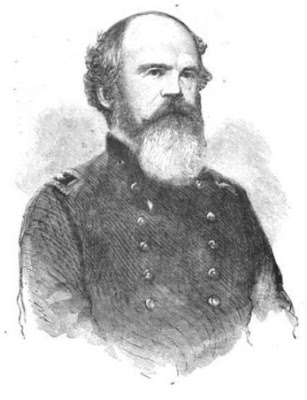 |
General Napoleon Bonaparte Buford.
(The Portrait Monthly. August 1863.) |
Napoleon Bonaparte Buford was born at Rose Hill, his family’s plantation
in Woodford County, Kentucky, on January 13, 1807. He graduated sixth in his
class at West Point in July 1827 and received a commission as second lieutenant
of Third United States Artillery. He was
assigned to the Topographical Engineers Corps from 1828-1830 and did the survey
for the slack water navigation in Kentucky. He later surveyed the land around Rock Island and the Des Moines River
rapids on the Mississippi.He took
a leave of absence from the military in the early 1830s to attend the Harvard
University Law School. After graduation, he taught natural and experimental philosophy
at West Point.
Like
many of his fellow West Point graduates, Buford found advancement in the
peacetime army next to impossible, so he resigned from the military in 1835. He
worked as a civil engineer in Kentucky, then relocated to Illinois in 1843,
where he worked as a banker, manufacturer, and later as president of the Rock
Island and Peoria Railroad.[ii]
He built
his home, called “Ivy Place,” in Rock Island somewhere around 1849-1850. The
inside walls were three feet thick, and it had a three-story circular
staircase. The home had thirteen rooms with a fireplace in each room.[iii]
At the
start of the civil war, Napoleon operated a bank in Rock Island. He was heavily
invested in the southern securities and the financial crisis that ensued
swamped his business. Buford signed everything he owned over to his creditors
and re-enlisted in the service, serving as a colonel in the 27th
Regiment of Illinois Volunteers. Abraham Lincoln appointed him a brigadier
general of volunteers in April 1862.
He
fought with General Ulysses S. Grant at Belmont Fort Henry and Fort Donelson. He
later distinguished himself in the fighting at Vicksburg and Corinth. “His
career has not been very showy,” noted the New York Daily Herald, “but
it has, nevertheless, been a brilliant one.”[iv]
Napoleon
served on the court-martial of General Fitz-John Porter after the Union debacle
at the Second Bull Run.
When General
Grant learned Lincoln intended to promote Buford to major general in 1865, he
vigorously protested his appointment. Napoleon Bonaparte Buford “would scarcely
make a respectable hospital nurse if put in petticoats,” exclaimed Grant. “He
is unfit for any military position. He has always been a dead weight to carry,
becoming more burdensome with his increased rank.”[v]



